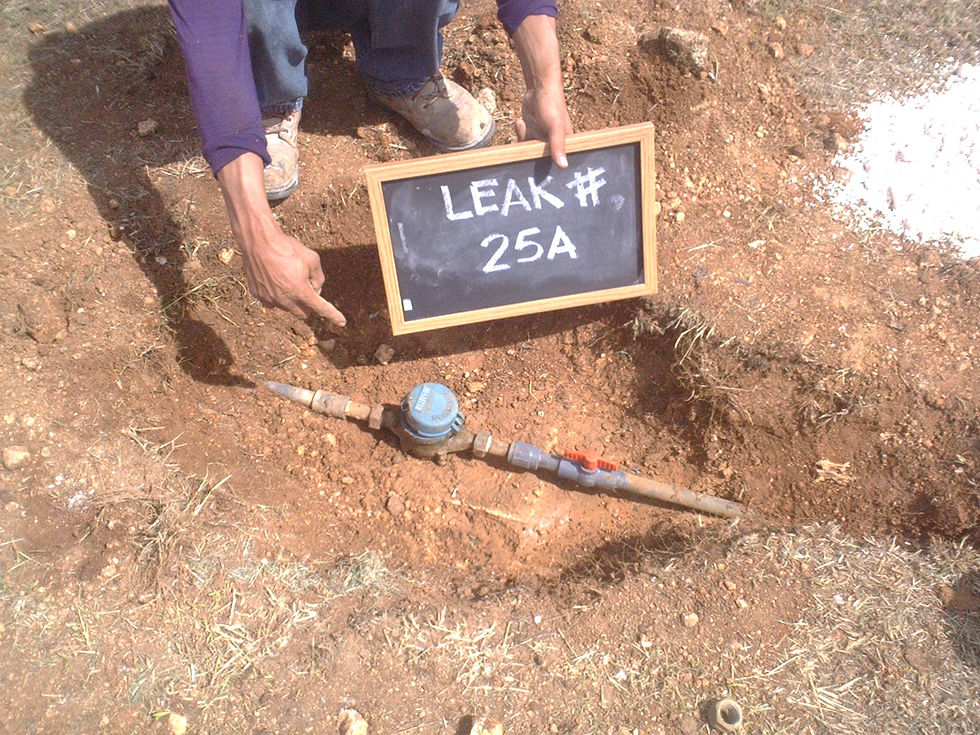Are all leaks the same?
- Cory Simonson
- Apr 9, 2021
- 3 min read
Updated: Apr 13, 2021
While all leaks lose the world’s most precious resource, water, they are not all treated the same.
Let’s look at the 6 most common leaks in a water system.
Main Line
Typically, mainline leaks are the largest and most expensive. Main lines differ in size but are substantially larger than the rest of the leak types. Main lines exist under major roads. With the increased traffic, potholes are more likely to develop, increasing the chances of unsafe road conditions as well as water loss.

These leaks are usually vertical or horizontal fractures of the pipe itself. While not a typical leak to find, when they occur they are expensive. Thankfully, the effect of a mainline leak will be obvious in a short manner of time, presenting itself in the increased water usage or damage to roads.
Average Annual Water Loss: 26,280,000 Gal/Year
Effect of Leak Going Undetected: Undermining subsurface infrastructure and compaction, sinkholes, a major liability
Pro-Tip: Main leaks are a priority to fix-it keeps residents a safe-primary way to stop non-revenue water loss.
Service Connection
Service connection leaks are mostly blown gaskets where the service line is attached to the corporation stop threaded into the mainline. Typically, these leaks occur from the water flowing through a larger pipe to a smaller diameter pipe that leads to the residence or business. As a result, the gasket will blow off the main with system pressure differences.

Unfortunately, without detection services, service connection leaks can go undetected for years. Some signs of these leaks include loss of pressure, but they are otherwise hard to detect without a proactive leak detection plan.
Average Water Loss: 10,512,000 Gal/Year
Effect: A larger possibility for leakage, leaks are generally isolated to where the service line connects to the larger water main. Leak undermines subsurface infrastructure and compaction. Mild liability.
Pro-Tip: When pinpointing a service connection leak, make sure you check the service line as well. A service line leak can cause the service connection to make a leak noise when the water flows through it supplying water to the service line leak. Without the extra verification step, a dry hole is possible at the service connection.
Service Line
Service lines bring water into residences or businesses. These leaks are the most common. These leaks are caused by a variety of things. First and foremost, corrosion is the primary factor of why service lines leak. Galvanized pipes will rust over time and cause pinhole leaks to major line breaks.
Average Water Loss: 10,512,000 Gal/Year
Effect: A larger possibility for leakage, leak can be anywhere on the service line undermining subsurface infrastructure and compaction, mild liability.
Pro-Tip: If the service line material is older in age. Replace the entire line when attempting a repair. Fixing a specific spot can cause future leaks on the line where the line is compromised already.
Curb stop Valve
Curb stop valves will leak on the upstream and downstream connection to the valve as well as the valve itself. These valves can stop pressure on a service line and should be checked regularly by water operators.

Often, debris, garbage, or leaves will get trapped around the curb stop valve. Over time, corrosion also attacks the connections to the curb stop as well, causing leaks to originate. If the valve is not operated frequently, the packing inside the valve will stick causing the valve to leak at the operating nut.
Average Water Loss: 525,600 Gal/Year (usually leaking an entire year)
Effect: Low priority. Usually low in volume in leakage, a leak can be in connection to the valve on both sides plus the valve itself.
Pro-Tip: When detecting the source of the leak, shut down the curb stop, then bleed the pressure to identify which side the leak is generating.
Pro-Tip: Water operators should check and clean the area around curb stop valves or inside of curb stop boxes at regular intervals.

Fire Hydrant
When it comes to fire hydrants, typically leaks will generate at the hydrant main valve. Debris will collect at the rubber seat of the main valve and damage it to the point that water escapes causing a leak.
Average Water Loss: 262,800 Gal/Year
Effect: Usually low in volume in leakage, sometimes can be fixed by flushing, easy to repair.
Pro-Tip: When shutting down the fire hydrant, go slow. Shutting it down fast will cause water hammer in the system and cause leaks.
Valve
Water Valve leaks tend to occur at the packing, often due to irregular operation. The valve packing is used to keep the valve operating nut from leaking while being operated. Sometimes the flange bolts and flanges attached to the pipes to the valves will rust away.
Average Water Loss: 525,600 Gal/Year
Effect: Low priority. Usually low in volume in leakage, sometimes can be fixed temporally by jamming the valve in the open position, which requires excavation to repair.
Pro-Tip: A valve maintenance program aids in the longevity of each valve in a water system.
Not all leaks are the same, some are big, some are small, but we can say that they all need to be located and repaired.








Comments